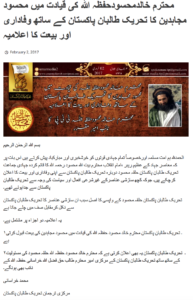A faction of the Pakistani Taliban that broke away from the Movement of the Taliban in Pakistan (TTP) in 2014 has rejoined the group, and its leader has been named the deputy emir of the TTP. The reunion is the latest in a series of moves that have brought wayward Taliban groups back into the TTP’s fold to help rebuild both its capacity and strength.
The TTP announced on Feb. 2 that the “Mehsud division,” which is also known as the Movement of the Taliban in South Waziristan and the Sajna or Khalid Mehsud Group, has rejoined the TTP, according to the SITE Intelligence Group, which obtained an English language version of the statement.
“Tehreek Taliban Pakistan [TTP] accepts the oath of allegiance of Mehsud Mujahideen under the esteemed Commander Khalid Mehsud Hafizahullah,” the TTP said. “TTP also declares that esteemed Commander Khalid Mehsud will be the representative of Mehsud division as well as deputy to the chief of TTP central Ameer Fazlullah Khorasani Hafizahullah.”
Khalid Mehsud is also known as Khan Said and Sajna Mehsud. He took control of the powerful Taliban faction after the death of Hakemullah Mehsud, the previous emir of the TTP. He declared the formation of the Movement of the Taliban in South Waziristan in 2014 and broke away from the TTP after a leadership dispute with Mullah Fazlullah. At the time of the split, the spokesman for Khalid’s group accused its parent organization of being “un-Islamic.” [See Discord dissolves Pakistani Taliban coalition.]
In its latest statement, the TTP said that Khalid Mehsud’s group returned after “the defection of the rogue elements to the rival parties.” SITE claims that this may be a reference to Khalifa Umar Mansour, who has conducted multiple attacks on Pakistani schools and other civilian institutions. The TTP has denounced some of Mansour’s attacks, but it is unclear if he has been expelled or if he withdrew from the parent organization.
The US added Mehsud to the list of specially designated global terrorists in October 2014. His forces are known to wage jihad in both Afghanistan and Pakistan.
The US has targeted his followers in airstrikes in Afghanistan and Pakistan. In Feb. 2016, US warplanes struck a meeting in the Afghan province of Paktika that Mehsud was expected to attend. Eighteen of his followers were reported to have been killed. In April 2015, US drones killed four of Mehsud’s followers in a strike in South Waziristan.
Mehsud’s supporters have executed several high profile attacks in the region, including the May 2011 assault on Naval Station Mehran in Karachi that resulted in the destruction of two US-supplied P-3C Orion maritime surveillance planes, and the 2012 prison break in Bannu, which freed Adnan Rasheed, a commander who has a long history with Pakistani terrorist groups as well as al Qaeda. US intelligence officials who track the TTP and al Qaeda in the Afghanistan-Pakistan region have told FDD’s Long War Journal that Mehsud remains a close ally of al Qaeda to this day.
The TTP has attempted to reunite various factions that broke away in 2014 after the US killed Hakemullah in a drone strike. In March 2015, Jamaat-ul-Ahrar, a powerful faction, rejoined the TTP. However, Jamaat-ul-Ahrar has operated with a degree of autonomy. At the same time, Lashkar-e-Islam merged with the Taliban. Additionally, three jihadist groups, all which are led by al Qaeda leader Matiur Rehman, merged with the TTP in May 2015.
Not all of the groups that split with the TTP have rejoined its ranks. One group of disaffected mid-level leaders joined the Islamic State’s Khorasan Province. Another faction in North Waziristan, led by Sheheryar Mehsud, who was loyal to Hakeemullah and TTP founder Baitullah Mehsud, is still thought to operate independently.










1 Comment
A Cockroach is a Cockroach by any other name. Joining this group of Cockroaches Vs the previous one doesn’t change one ultimate criteria.
THEY ALL NEED TO BE DRONED.